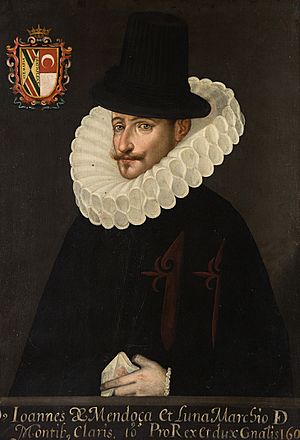Juan de Mendoza y Luna, Marquis of Montesclaros facts for kids
Quick facts for kids
Juan de Mendoza y Luna
Marquis of Montesclaros
|
|
|---|---|
 |
|
| 11th Viceroy of Peru | |
| In office December 21, 1607 – December 18, 1615 |
|
| Monarch | Philip II |
| Preceded by | Diego Núñez de Avendaño |
| Succeeded by | Francisco de Borja y Aragón |
| Personal details | |
| Born | January 1571 Guadalajara |
| Died | 9 October 1628 Madrid |
Juan de Mendoza y Luna, 3rd Marquis of Montesclaros (born January 1571 – died October 9, 1628) was an important Spanish nobleman. He was also a skilled writer and a high-ranking official. He served as the tenth Viceroy of New Spain (which is now Mexico) from 1603 to 1607. After that, he became the Viceroy of Peru from 1607 to 1615. When he returned to Spain, he became a trusted advisor to the king.
Contents
Juan de Mendoza y Luna: A Spanish Leader
Early Life and First Steps
Juan de Mendoza y Luna was born in Guadalajara in January 1571. He was born after his father, the 2nd Marquis of Montesclaros, had passed away. His mother, Isabel Manrique de Padilla, raised him.
He joined the army and served bravely in a campaign in Portugal. For his excellent service, he received a special award called the Order of Caballero de Santiago in 1591. Later, he became the governor of Seville. This job helped him learn a lot about the Spanish colonies in the Americas. On May 19, 1603, the King of Spain chose him to be the Viceroy of New Spain.
Governing New Spain
Juan de Mendoza y Luna officially arrived in Mexico City on October 26, 1603. He was with his wife, Ana de Mendoza, and immediately began his duties as viceroy. He had some disagreements with the previous leader about how money was spent. Plans to explore and settle Alta California were stopped during his time.
Tackling Mexico City's Floods
In August 1604, Mexico City experienced a very large flood. The damage was widespread and serious. At first, the viceroy thought about moving the capital city to higher ground in Tacubaya. However, this idea was too expensive. So, he decided to finish a large drainage canal project in Huehuetoca. This was a huge task that needed 15,000 native workers and many years to complete.
While the canal was being built, he worked to fix the walls (dikes) that held back water. He also paved many streets in the city, including San Antonio Abad and Chapultepec. Even with these efforts, some parts of the city stayed underwater for a whole year.
Improving the City
Viceroy Mendoza y Luna also built an aqueduct. This was a system of stone arches that brought fresh water from the springs in Chapultepec to the center of Mexico City. He made sure the water channels were clean and paved many streets with cobblestones. He also made it easier for native people to return to their lands and live there.
Leading in Peru and Later Years
On November 20, 1606, Juan de Mendoza y Luna was chosen to be the Viceroy of Peru. He stayed in New Spain until the new viceroy arrived in July of the next year. Then, he sailed from Acapulco to Lima, Peru.
He served as Viceroy of Peru until 1615. During his time in Lima, he oversaw the building of the famous Stone Bridge and the Alameda de los Descalzos, which is a beautiful public park. He returned to Spain in 1616. There, he became an important advisor to the king on government and military matters. Later, he was in charge of the country's money and also led the council of Aragon. In 1621, King Philip IV gave him a very high noble title, making him a Grandee of Spain.
Juan de Mendoza y Luna passed away in Madrid on October 9, 1628, when he was 57 years old.
See also
 In Spanish: Juan de Mendoza y Luna para niños
In Spanish: Juan de Mendoza y Luna para niños

